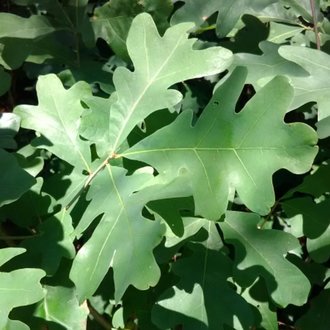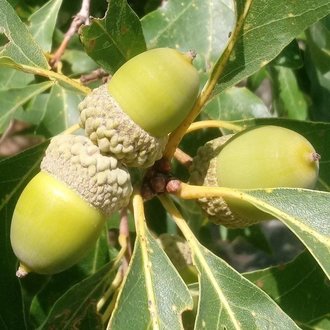White Oak vs Swamp White Oak
These two oaks are sometimes confused; young white oaks growing in shade have shallowly-lobed leaves that can be confused with those of swamp white oaks. Although swamp white oaks are naturally found on wetter sites, both species are widely planted and can be found together in landscaping. The species are usually easily distinguished if you know what to look for. They can, however, hybridize and form intergrades; although hybrids are rare, it may not be possible to identify all trees.
White Oak (Quercus alba) | Swamp White Oak (Quercus bicolor) |
A widespread oak that is a key component of forests across eastern North America, often found in slightly dry conditions. | A large white oak native to eastern North America, favoring poorly-drained habitats. |
Leaves growing in sun usually have deep sinuses between lobes. Lobe tips are consistently rounded. Photo © Katja Schulz, CC BY 4.0. | Leaves, even those growing in sun, usually have shallower sinuses between lobes. Lobe tips may be rounded, but are usually less so, and sometimes come to an abrupt point. Photo © , CC BY-SA 4.0. |
Leaves have less color contrast between top and bottom; leaves have paler, whitish color above and are less shiny. Underside not fuzzy. Photo © Claire Secrist, Public Domain. | Leaves usually have strong contrast between shiny, dark green above and whitish underside with soft and fuzzy texture. Photo © Reuven Martin, Public Domain. |
Acorn cap covers less of the nut, usually about 1/4. Acorn cap scales lack awns. Acorns often more oblong. Photo © Even Dankowicz, CC BY 4.0. | Acorn cap covers more of the nut, often 1/2 to 3/4. Acorn cap scales have short awns, leading the cap to have a slightly spiky texture. Photo © luka.r.s (Flickr), CC BY-SA 4.0. |
Bark light gray and scaly. Photo © Ken Kneidel, Public Domain. | Bark darker gray; may be scaly, but usually has longer ridges. Bark of young branches peeling. Photo © , CC BY-SA 4.0. |
References & External Resources
These short lists show only links helpful for ID. For a complete list of references and resources also covering other aspects of ecology, visit the links section of the full article on each plant, which is the first entry here.










